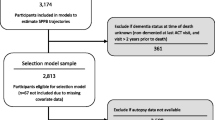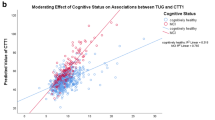Abstract
Background
Physical performance tests are simple means of predicting an individual’s risk of cognitive decline.
Aims
This study aimed to assess the predictive value of physical performance tests and develop predictive models for cognitive function.
Methods
Cognitive function was tested biennially and calculated for mental intactness, episodic memory, and global cognition. Using a generalized estimating equation (GEE), we examined each baseline physical performance test as a predictor of cognitive decline. Using a multivariate linear regression model (MLRM), we developed predictive models for cognitive function. Bland–Altman analysis was performed to analyze the agreement between estimated and measured cognition. We validated the predictive model internally with 1000 bootstrap resamples.
Results
Better physical performance test results, except for standing balance, were associated with a slower cognitive decline over time and better cognitive function at follow-up. Regarding the predictive models, all physical performance tests were included in men; only five chair stands test was included in women. Bland–Altman analysis showed that measured cognition was equivalent to estimated cognition in men (mean bias, 0; 95% limits of agreement, − 8.56 to 8.56) and women (mean bias, 0; 95% limits of agreement − 8.79 to 8.7). Bootstrap analysis showed that predictors were selected in 78.4–100% for men and 64.5–100% for women.
Discussion
Bland–Altman and bootstrap analysis demonstrated good agreement and stability of the predictive models.
Conclusions
Physical performance tests are simple, easily obtainable, and clinically relevant markers for cognitive function with aging; predictive models based on physical performance can be used to predict cognitive function.




Similar content being viewed by others
Availability of data and materials
The datasets generated during and/or analyzed during the current study are available from the corresponding author on reasonable request.
References
The Lancet (2016) Ageing in China: a ticking bomb. Lancet 388:2058
Murray CJL et al (2013) UK health performance: findings of the Global Burden of Disease Study 2010. Lancet 381:997–1020
Veronese N et al (2016) What physical performance measures predict incident cognitive decline among intact older adults? A 4.4 year follow up study. Exp Gerontol 81:110–118
Stijntjes M et al (2017) Temporal relationship between cognitive and physical performance in middle-aged to oldest old people. J Gerontol A Biol Sci Med Sci 72:662–668
Liu Y et al (2019) A prospective study on the association between grip strength and cognitive function among middle-aged and elderly Chinese participants. Front Aging Neurosci 11:250
Guralnik JM et al (1994) A short physical performance battery assessing lower extremity function: association with self-reported disability and prediction of mortality and nursing home admission. J Gerontol 49:M85–M94
Guralnik JM et al (1995) Lower-extremity function in persons over the age of 70 years as a predictor of subsequent disability. N Engl J Med 332(9):556–561
Volpato S et al (2011) Predictive value of the Short Physical Performance Battery following hospitalization in older patients. J Gerontol Ser A Biol Sci Med Sci 66:89–96
Zhao Y et al (2014) Cohort profile: the China Health and Retirement Longitudinal Study (CHARLS). Int J Epidemiol 43:61–68
Andresen EM et al (1994) Screening for depression in well older adults: evaluation of a short form of the CES-D (Center for Epidemiologic Studies Depression Scale). Am J Prev Med 10:77–84
Zeger SL, Liang KY, Albert PS (1988) Models for longitudinal data: a generalized estimating equation approach. Biometrics 45:347
Zeger SL, Liang KY (1986) Longitudinal data analysis for discrete and continuous outcomes. Biometrics 42:121–130
Austin PC, Tu JV (2004) Bootstrap methods for developing predictive models. Am Stat 58:131–137
Bland JM, Altman DG (1986) Statistical methods for assessing agreement between two methods of clinical measurement. Lancet (London, England) 1:307–310
Giavarina D (2015) Understanding Bland Altman analysis. Biochemia Medica 25:141–151
Legdeur N et al (2020) What determines cognitive functioning in the oldest-old? The EMIF-AD 90+ Study. J Gerontol Ser B Psychol Sci Soc Sci. https://academic.oup.com/psychsocgerontology/advance-article/doi/10.1093/geronb/gbaa152/5902948. Accessed 8 Sept 2020
Stijntjes M et al (2016) Temporal relationship between cognitive and physical performance in middle-aged to oldest old people. J Gerontol Ser A Biomed Sci Med Sci 72:662–668
Jeong S, Kim J (2018) Prospective association of handgrip strength with risk of new-onset cognitive dysfunction in Korean Adults: a 6-year National Cohort Study. Tohoku J Exp Med 244:83–91
Wang T et al (2019) Weak grip strength and cognition predict functional limitation in older Europeans. J Am Geriatr Soc 67:93–99
Carson RG (2018) Get a grip: individual variations in grip strength are a marker of brain health. Neurobiol Aging 71:189–222
Nishita Y et al (2019) Links between physical frailty and regional gray matter volumes in older adults: a voxel-based morphometry study. J Am Med Dir Assoc 20:1587–1592
Yoon DH et al (2018) Physical frailty and amyloid-β deposits in the brains of older adults with cognitive frailty. J Clin Med 7:169
Rolland Y et al (2009) An abnormal “one-leg balance” test predicts cognitive decline during Alzheimer’s disease. J Alzheimer’s Dis JAD 16:525–531
Sattler C et al (2011) Physical fitness as a protective factor for cognitive impairment in a prospective population-based study in Germany. J Alzheimer’s Dis JAD 26:709–718
Lam FM et al (2018) Physical exercise improves strength, balance, mobility, and endurance in people with cognitive impairment and dementia: a systematic review. J Physiother 64:4–15
Verghese J et al (2014) Motoric cognitive risk syndrome: multicountry prevalence and dementia risk. Neurology 83:718–726
Fried LP et al (2001) Frailty in older adults: evidence for a phenotype. J Gerontol Ser A Biol Sci Med Sci 56:M146–M156
Grande G et al (2019) Co-occurrence of cognitive impairment and physical frailty, and incidence of dementia: systematic review and meta-analysis. Neurosci Biobehav Rev 107:96–103
Kelaiditi E et al (2013) Cognitive frailty: rational and definition from an (IANA/IAGG) international consensus group. J Nutr Health Aging 17:726–734
Lv Y-B et al (2017) A U-shaped association between blood pressure and cognitive impairment in chinese elderly. J Am Med Dir Assoc 18:193.e7
Shen S et al (2015) Uncontrolled hypertension and orthostatic hypotension in relation to standing balance in elderly hypertensive patients. Clin Interv Aging 10:897–906
Acknowledgements
We thank the China Center for Economic Research, the National School of Development of Peking University for providing the data, and we also acknowledge all the participants in the survey design and data collection as well as the CHARLS research team for collecting high-quality, nationally representative data.
Funding
This research project was supported by grants from the National Key R&D Program of China (2018YFC2001605), National Natural Science Foundation of China (81571756), Shanghai Municipal Commission of Health and Family Planning Foundation (2020YJZX0105), Shanghai Clinical Research Center for Mental Health (19MC1911100), Shanghai Mental Health Center (CRC2017ZD01), Shanghai Municipal Science and Technology Major Project (No. 2018SHZDZX03) and ZJLab.
Author information
Authors and Affiliations
Contributions
The data used in this paper are from China Health and Retirement Longitudinal Study (CHARLS). We applied the permission for the date access (http://charls.pku.edu.cn/zh-CN) and got the access to use it. Prof. Yaohui Zhao (National School of Development of Peking University), John Strauss (University of Southern California) and Gonghuan Yang (Chinese Center For Disease Control And Prevention) are the principle investigator of CHARLS, and they make the data available online for academic use freely. YL, XYC and CBL designed this study. YL and XYC acquired the data. YL performed the statistical analysis, assisted by XYC and reanalyzed by LJJ. YL drafted the manuscript. XYC and CBL reviewed the manuscript and all the authors approved the final version for submission.
Corresponding authors
Ethics declarations
Conflict of interest
The authors declare that they have no conflict of interest.
Statement of human and animal rights
This study including human participants has been performed in accordance with the ethical standards laid down in the Declaration of Helsinki and its later amendments.
Ethical approval
Ethics approval for the data collection in CHARLS was obtained from the Biomedical Ethics Review Committee of Peking University (IRB00001052-11015).
Informed consent
Each participant included in this study signed a written informed consent form before taking part in the survey.
Additional information
Publisher's Note
Springer Nature remains neutral with regard to jurisdictional claims in published maps and institutional affiliations.
Supplementary Information
Below is the link to the electronic supplementary material.
Rights and permissions
About this article
Cite this article
Liu, Y., Gu, N., Jiang, L. et al. Predicting cognitive function based on physical performance: findings from the China Health and Retirement Longitudinal Study. Aging Clin Exp Res 33, 2723–2735 (2021). https://doi.org/10.1007/s40520-021-01810-5
Received:
Accepted:
Published:
Issue Date:
DOI: https://doi.org/10.1007/s40520-021-01810-5




